After a successful Alpha Season 3, what’s next for this leading metaverse?
The Sandbox (TSB) is a virtual world where users can create monetizable gaming and social experiences. The platform runs on Polygon, inheriting the sidechain’s low gas and sustainable characteristics. Furthermore, the game’s free building tools, Game Maker and VoxEdit, allow developers and content creators to participate, create and develop interactive content.
On November 2, The Sandbox’s Alpha Season 3 ended. During 68 days, the event attracted 353,000 unique users across 98 new brand-generated experiences. For the first time, gamers could utilize avatars from other Web3 brands, showcasing The Sandbox’s high focus on interoperability. The Sandbox defied the crypto winter posting positive numbers in terms of Unique Active Wallets and trading volume over the last months.
This report intends to provide a general perspective on the current state of The Sandbox, as well as a review of relevant concepts regarding LAND in this virtual world.
Contents
Understanding LANDs inside The Sandbox
A LAND in The Sandbox is an ERC-721 token acting as a digital piece of real estate where creators can build voxel metaverse experiences. The Sandbox consists of 166,464 NFTs representing virtual plots. Each 1×1 LAND comes with a predefined terrain of 96 meters in width, 96 meters in length, and 128 meters in height.
Adjacent 1×1 land plots can be grouped in The Sandbox to form estates of different sizes. The largest size (XL) for adjacent lands is 24×24, comprising 576 LANDs. Parcels of this size cover more than 12% of The Sandbox’s map and boast renowned holder names, including Atari, Pranksy, Cyber Kongz, Binance, Ubisoft, Socios, The Walking Dead, Gemini, CoinMarketCap, MetaKey, Republic Realm, Warner Music Group, and South China Morning Post.

Large estates with a 12×12 size contain 144 adjacent LANDs and are owned by famous names like Adidas, Snoop Dogg, CryptoKitties, Yield Guild Games, Ultra, Smurfs, Care Bears, and GuildFi, among other Web3 celebrities.
Finally, Medium and Small plots constitute the most accessible opportunities to own The Sandbox land and are available at public sales. For reference, during February’s Metavex sale, the winning bid for the Metavex Medium land was 215,000 SAND or around $630,000 (USD), while the auction of Small estates reached 45,000 SAND or $130,000.
Premium LANDs
Apart from the estate size, LANDs can be classified according to their location on the map. Premium LANDs are those areas surrounding major partners or social hubs. These grounds see high user traffic due to their strategic location. Branded experiences attract many users, while players joining the virtual world through the social hubs’ portals will carry exploration traffic outwards.
High traffic levels appraise the value of adjacent parcels as the monetization opportunity in these areas increases. For instance, The Walking Dead, Sueco, Ubisoft’s Rabbids, and Steve Aoki’s experiences registered over 100,000 unique users during Alpha Season 3. Thus, advertisements, rent, and pay-to-play gaming fees in premier estates become more expensive.
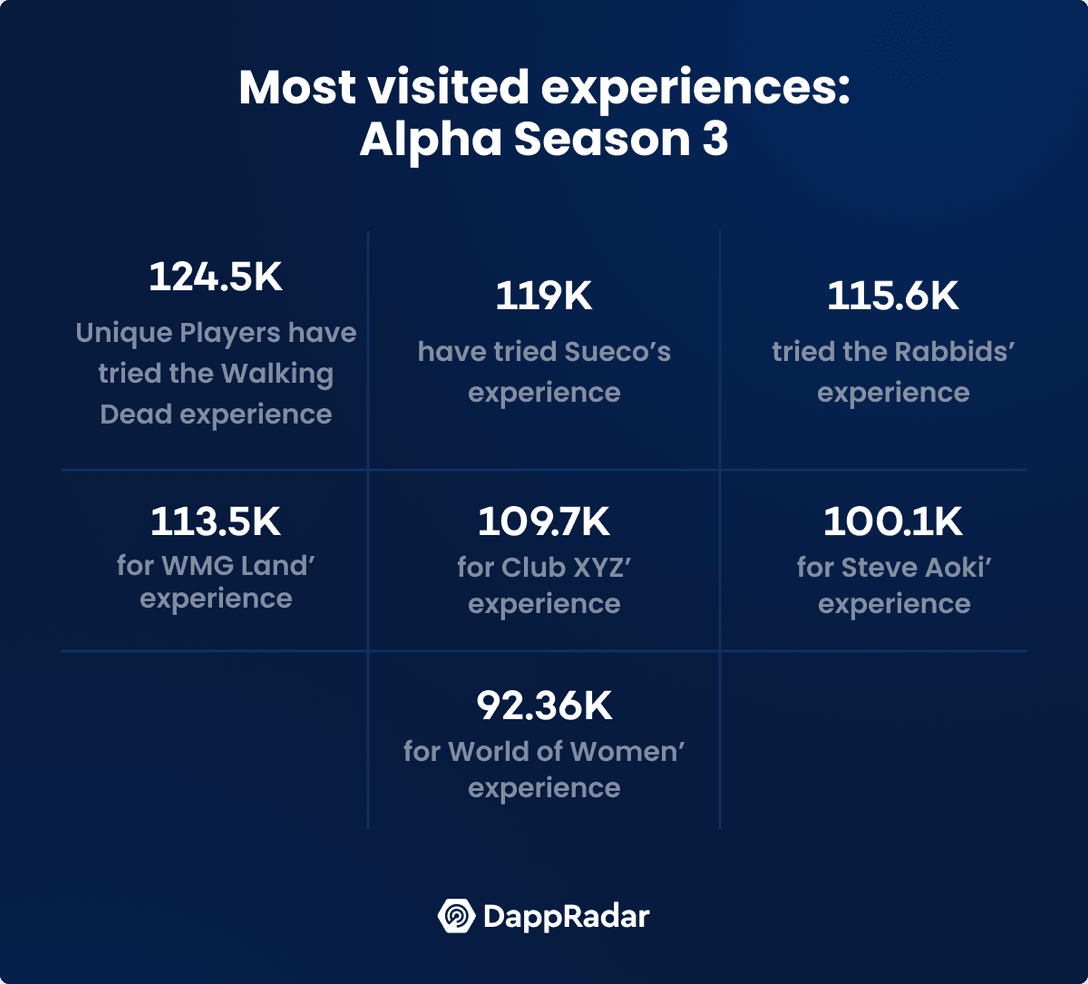

The primary or initial sale of Premium lands comes with exclusive, limited-time assets considered Premium assets. Due to their rarity, Premium assets have a higher value than regular TSB assets.
It is important to note that the Premium assets are only attached to the Premium land at the time of mint. When purchasing Premium land in the secondary market, it is up to the seller to bundle Premium assets as part of the trade.
LAND Distribution
From the total LAND supply, 10% (16,704 land plots) will remain in The Sandbox’s control to host special events and feature exclusive games. A further 16% or 25,920 LANDs will be used as a reserve to be distributed to strategic partners or released to creators and gamers as rewards. However, the remaining 123,000 LANDs are up for sale to the public. At writing, over 80% of these LANDs available for public sale have already been sold.
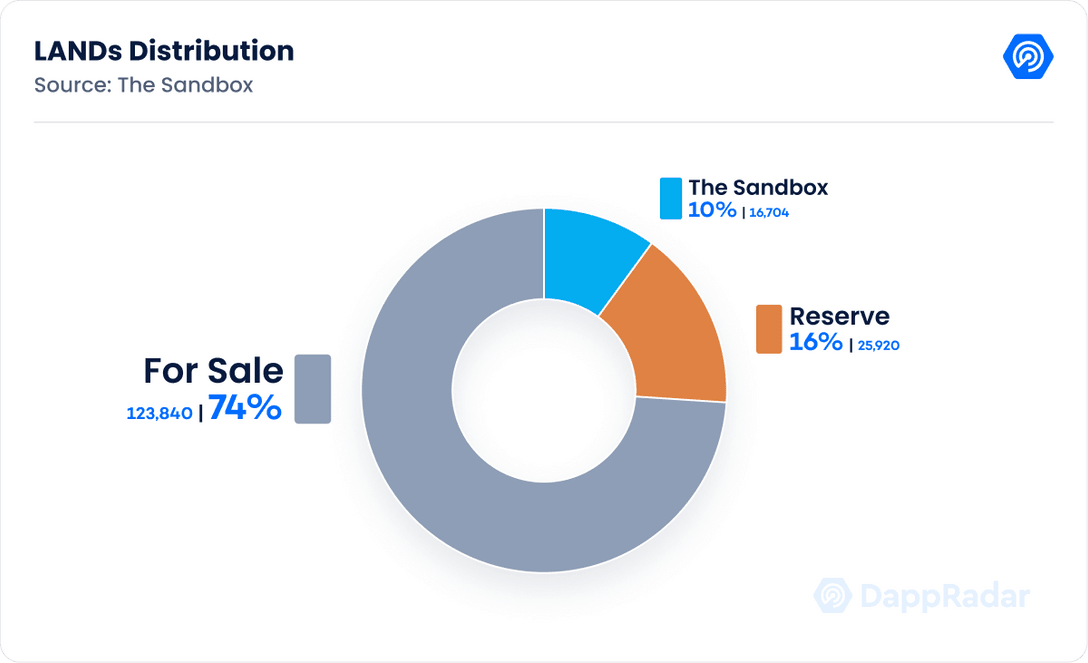

The Sandbox defies the bear market behind Alpha Season 3
Over the last eight months, the crypto industry has been trapped in a bear trend. The price of every cryptocurrency is down from the all-time highs registered one year ago. Meanwhile, the NFT trading volumes are at their lowest since June 2021. However, despite the challenging market conditions, The Sandbox sidesteps the crash with its successful Alpha Season 3 and the recent milestones reached in its roadmap.
The Sandbox Alpha Season 3 ran for almost 70 days, with multiple experiences from renowned brands open to alpha gamers. Over 220,000 unique users visited the metaverse during the event, while more than 1.6 million unique users visited the official website. Blockchain or on-chain data confirms the hype as more than 10,800 Unique Active Wallets (UAW) interacted with The Sandbox game and marketplace contracts, growing 23% from the end of August.
As experiences from The Walking Dead, Steve Aoki, and Sueco became popular attractions, the demand for Sandbox LANDs visibly grew. At writing, there are over 22,500 unique landowners, an all-time high, even though The Sandbox hasn’t released new LANDs since the start of the Alpha in August.
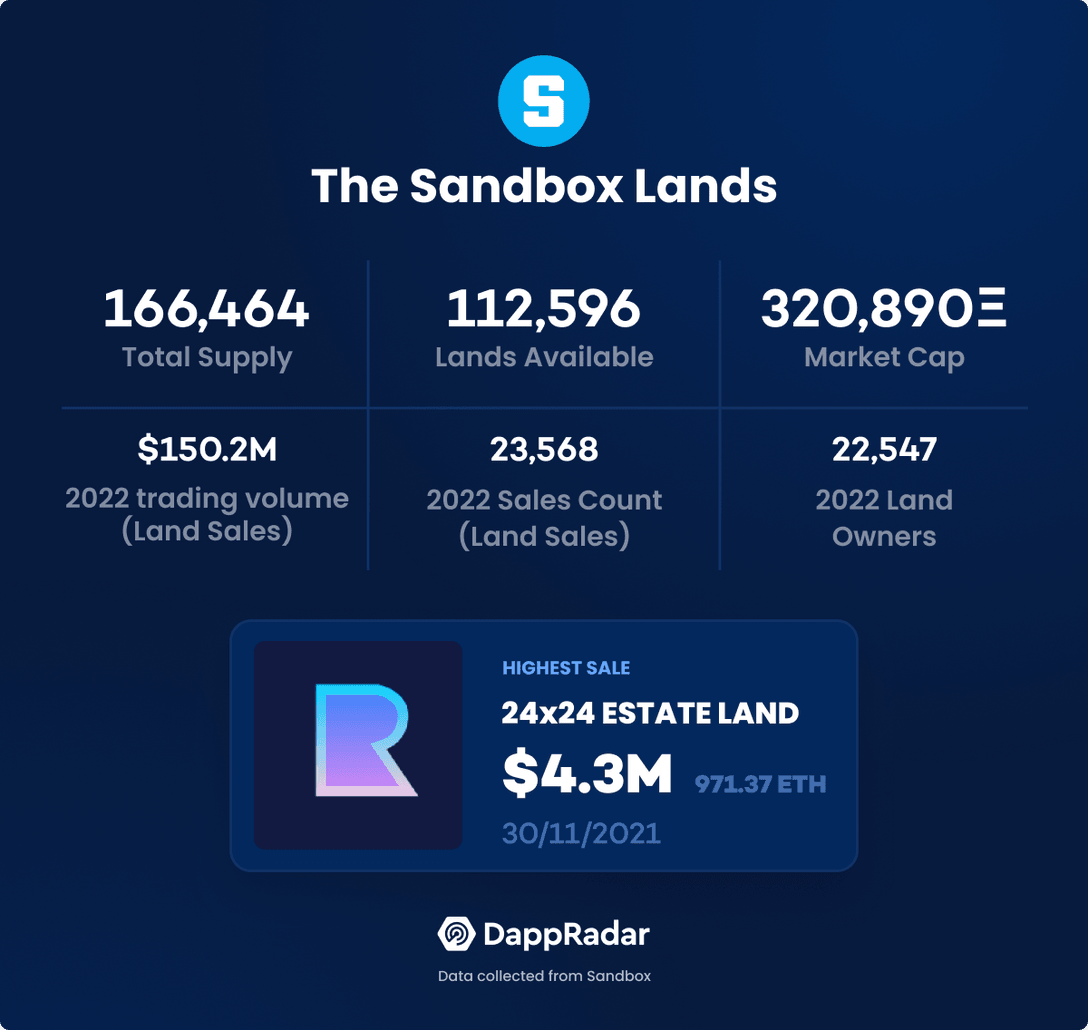

Moreover, NFT metrics for Sandbox LANDs show a slight recovery, breaking the overall virtual world market trend that has been plummeting since Q1 this year. Since August, The Sandbox LANDs have generated over $6.1 million in volume from almost 3,900 LAND sales. Both metrics are the second best in the industry in that period, lagging only Otherside.


While the Alpha Season 3 immersive gaming experiences propelled the recent surge in LAND demand, the high levels of SAND distributed through staking remind us about yet another impactful trait of The Sandbox LANDs: staking.
How to monetize LAND in the Sandbox?
The ability to stake LANDs is one of the most enticing aspects of The Sandbox virtual estate. Those that bridged their LANDs from Ethereum to Polygon can participate in the new SAND staking program that started on September 22. In this staking campaign holders can invest up to 500 SAND per LAND to generate passive income paid in SAND tokens. The more LAND NFTs someone holds, the more SAND they are allowed to stake.
SAND is the governance token of The Sandbox ecosystem. Earning staking rewards in SAND increases LAND NFT utility while acting as a community catalyzer.
Apart from providing passive income and increasing the governance voting power, there is significant potential to monetize Sandbox LANDs, and these opportunities come in different forms:
- Hosting immersive experiences
- Renting the LAND
- Host contests & giveaways
- Selling asset NFTs
- Selling LANDs
Let’s discuss each of these opportunities.
Hosting immersive experiences
The primary function of LANDs on The Sandbox is to enable users to host gaming and social experiences. Owners can use the platform’s Game Maker tool to create immersive spaces such as games, art galleries, stores, dioramas, interactive education, and so on. The creations are published on top of the virtual land, and the owner can charge a fee to users interested in trying their experience.
Renting the LAND
Like in the real world, the metaverse allows virtual land owners to rent their properties in digital reality. In The Sandbox, LAND owners can monetize their lands by renting them to other users keen to build any experience on top of the parcel. As the metaverse adoption continues its unstoppable progression, digital real estate brokers could become more popular.
By renting LANDs, game designers and development studios that missed out on the first sales will be able to design their own experiences. In this way, The Sandbox follows an open economy enabling a p2p real estate market.
Host Contests & Giveaways
On LANDs, contests, and giveaways can be organized, enticing a healthy number of paying consumers to visit that LAND to participate in the contest or giveaway. Alternatively, the LAND owner might, for a price, permit others to organize contests or giveaways on their LANDs to advertise themselves.
Selling asset NFTs
When the LAND owner publishes an experience, they will also be able to impose admission conditions and charge a price. One of the entry conditions they can impose is that gamers must possess a particular asset NFT beforehand. For instance, to play a swashbuckling pirate game that they have published on the LAND, the player may be forced to purchase a sword from an NFT sword collection that they have also listed on the marketplace.
Selling LANDs
The most straightforward way to monetize LAND is by flipping it and selling it on a secondary marketplace.
Dissecting The Sandbox’s LAND potential
How much is the metaverse expected to be worth by 2030? Numbers are as random as darts shot at a dartboard by analysts attempting to predict the future. $750 billion says Frost & Sullivan, $5 trillion, says McKinsey; while Citi even claims $13 trillion. All three may be correct or incorrect, depending on certain economic models, technological advancements, and customer preferences.
Regardless of the exact number, the metaverse allows businesses to tap into a multibillion-dollar market, if not a multi-trillion-dollar market. The exponential growth of NFTs, blockchain technology, and metaverse platforms creates new opportunities for experts with keen vision. Despite the bear market, the increase in venture capital funding supports a lively community that seeks to reach new customers, businesses, and audiences.
Metaverse interoperability
Interoperability represents one of the biggest challenges on the metaverse roadmap. An interoperable metaverse means that users on one platform can communicate, interact, and share data and content with users on another platform.
For users, an interoperable metaverse means they’ll be able to move from world to world without switching avatars, wallets, or assets. Features such as interoperable avatars will draw audiences looking to build and customize their virtual identities, further defining ownership, personal expression, and social interactions in an interoperable metaverse.
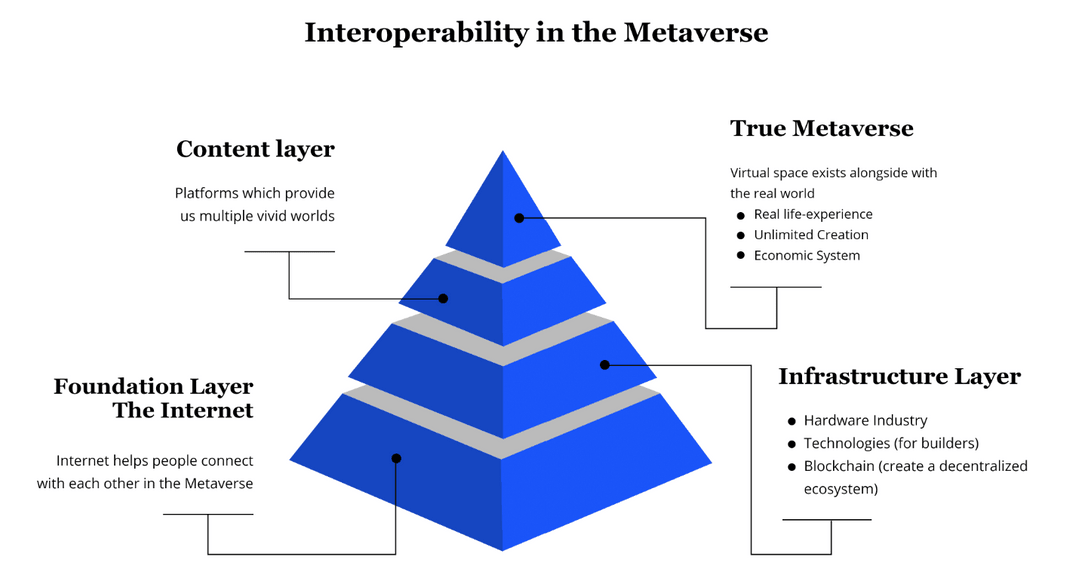

In terms of interoperability, The Sandbox should be considered among the leaders. The Alpha Season 3 was one of the most significant interoperability use cases to date, with NFT owners able to use digital avatars from Web3 brands such as Bored Ape Yacht Club, Doggies, World of Women, CoolCats, and Clone X. Additionally, The Sandbox has partnered with over 200 brands and influencers to shape its virtual landscape.
Shaping the creator economy
This booming economy has been thriving for years, with a current estimated $20 billion market value, according to the CEO of Patreon. Despite the rapid expansion of social platforms such as Instagram and TikTok, it is essential to recognize that these companies are only meaningful thanks to the content producers and their audience.
Influencer marketing on major social platforms has increased by 50% over the previous five years, illustrating the trend toward consumer brand marketing driven by influencers and content creators.
This move benefits the expansion of the metaverse, as a sizable proportion of new and interesting experiences will likely originate from content creators who join as users. It echoes the trend initiated by Web2 social media, but enriches it with digital ownership and personal branding.
Essentially, the continuing study of the metaverse fosters the growth of the creator economy. This is especially true of crypto integrations and decentralized platforms, which give creators a way to make money. As developers build projects on these decentralized architectures, there will be more opportunities for independent producers to join metaverse communities and share their content.
The metaverse will be an empowering opportunity for influencers and artists of all kinds, for anyone with the drive and ability to be content creators. And The Sandbox excels at providing developers and content creators with tools to reach their full potential.
Empowering virtual freelancers
The past decade has seen the creation of totally new economic segments due to digitalization. Companies like Uber and Lyft and websites like Upwork and Fiverr have contributed to the emergence of a worldwide gig economy. Now, metaverse platforms are proliferating, providing numerous earning opportunities for gig economy workers.
For example, The Sandbox knows that it must incentivise and attract artists and developers in large numbers to replicate the success of its Web2 predecessors. Therefore, it offers numerous opportunities to earn from content creation, development, and participation.
There will be many opportunities to monetize gig worker abilities, ranging from digital event planning to DJing virtual events. Features seen in various real-world sectors, such as entertainment, commerce, social and business services, will have a place within the ecosystem provided by The Sandbox.
NFTs have already significantly impacted the gig economy, with almost two-thirds of freelancers looking for gigs within the NFT industry on gig working sites like Fiverr. This is likely due to the demand for creatives and professionals to assist with expanding and growing new web3 and metaverse ventures.
We are just beginning to scratch the surface of possibilities for gig workers in the metaverse. Hundreds of new metaverse-enabled virtual worlds are in the works, offering revenue generation options for all those who wish to engage and develop.
The future of music and entertainment
In the last two or so years, virtual events have gained significant appeal. The metaverse’s innovations will provide essential assistance for upgrading virtual events in the present and future. Deadmau5 and Snoop Dogg have hosted full-fledged virtual concerts in the past year, with the latter owning one of the most popular experiences in The Sandbox.
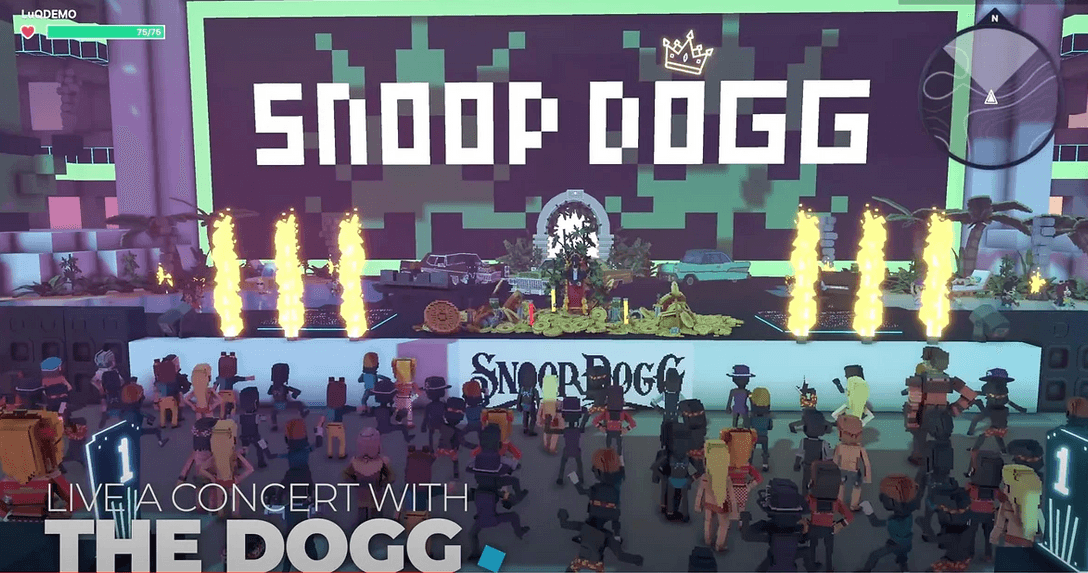

Beginning this year, Warner Music and The Sandbox have started working together to make a metaverse universe that is all about music. Warner Music artists will perform live concerts and other music experiences in this world.
Slipknot, an American alternative metal band, announced a cooperation with The Sandbox on April 19 to establish “Knotverse”, a new world in The Sandbox that will offer immersive experiences to its users. Furthermore, the third season of Sandbox Alpha featured various musical performances by Sueco, Steve Aoki, Paris Hilton, etc.
With attendance figures in the tens of millions for a virtual concert, as seen in the Travis Scott concert in the Fortnite, the accessibility and scalability of events are one of the primary advantages of a metaverse concert. Almost anyone in the globe can purchase a ticket to a virtual event, as the location is no longer a consideration.
Immersive e-commerce experience
The ongoing growth and popularity of e-commerce has made online stores a crucial component of any organization’s strategy. The retail industry has become the next primary testing ground for metaverse commercial potential.
Immersive shopping experiences can be advantageous for retail businesses. Additionally, the metaverse will be an ideal environment for introducing new products, goods, and services.
The ability to browse digital retailers like Alibaba, Gucci, Zara, Balenciaga, Nike, and Alo Yoga in a 3D immersive virtual environment would elevate the internet buying experience to an entirely new level.


An immersive shopping experience in the metaverse will enable the user to virtually try on apparel, shoes, and jewelry in ways that translate more closely to the actual world. Moreover, because your digital avatar is an extension of yourself, you would feel more connected to the online product and purchasing experience, bridging the gap between traditional e-commerce and real-world shopping.
Before investing in a physical product, a firm that has established itself in the metaverse can utilize it as a platform to launch new items and gain direct customer feedback. By establishing a favorable rapport with those who are devoted to your brand or product in the metaverse, you expand your audience and give your company more opportunity to do market research through immersive experience trials.
Experience of learning that is completely immersive
The immersive experiences made possible by the metaverse can be transferred to medical education, higher education, military applications, and numerous other applications that could benefit from immersive learning. Importantly, organizations do not need to create new infrastructure to facilitate immersive learning because it is available virtually via the metaverse.
The application of education in the metaverse would involve the usage of virtual reality (VR) settings and the superimposition of digital information on the actual world using VR headsets. Therefore, VR learning would be essential since it may let pupils interact more effectively with informational concepts and ideas. Moreover, immersive education in the metaverse could aid in detecting student faults and make it simpler for educators to update the curriculum.
Inside The Sandbox, anyone can create and share virtual worlds that can occur simultaneously virtually or physically, which could lead to the development and deployment of virtual classrooms. Here, participants are not constrained by geographic location or physical space. Furthermore, teachers can take students on immersive historical scenarios or scientific experiments through the security and convenience of their laptops.
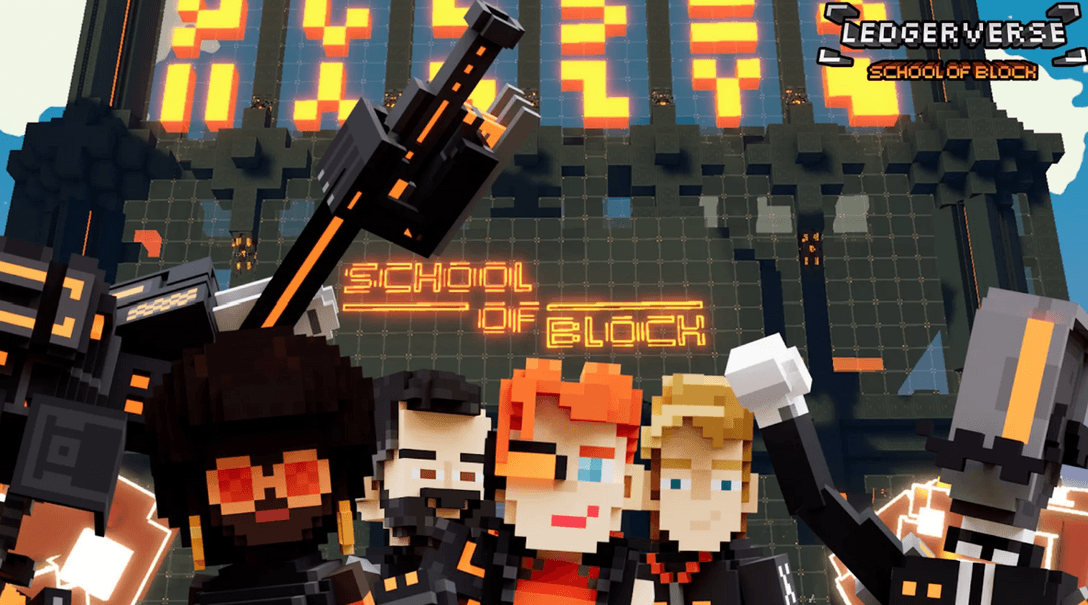

In April, the leader in crypto hardware wallets, Ledger, partnered with The Sandbox.
Initially, it was only a concept. It is now a reality. With the assistance of the metaverse agency and co-creator Swipe Back, Ledger set up shop in The Sandbox and developed a Minecraft-inspired school that incorporates gaming with bitcoin instruction. Players may earn NFTs while learning about the blockchain and its risks, and they don’t need a cryptocurrency wallet to get started.
Regarding the accessibility of learning in the metaverse, the most significant aspect is that any commercial prospects given in education will provide immersive learning experiences in any language without translation obstacles. What is more, we are just one successful learning model away from kickstarting the next big trend: learn-to-earn.
Rising government adoption
Since the beginning of the last quarter, we have seen a rise in government adoption, which has been most notable in Asian economies. Several metaverse initiatives will get an investment of more than 177.1 billion won ($128.8 billion) from South Korea. The money would first be utilized to develop a metropolitan-level metaverse platform that would provide digital access to various government programs and services.
Following this, the Beijing municipal administration has published a two-year metaverse innovation and development strategy. This project focuses on promoting the growth of metaverse-related businesses and assisting Beijing in becoming a model digital economy city.
Two major Chinese cities have published multi-year action plans focusing on the metaverse and NFTs in the past several months. Prior to Beijing, Shanghai also put the metaverse into its five-year growth plan, vowing to establish a metaverse business worth 350 billion yuan (about $51 billion) by the end of 2025.
Moreover, the artificial intelligence ecosystem Multiverse Labs has created a new metaverse city in the United Arab Emirates (UAE), a move that the emirate believes would boost the tourism business in the region.


Multiverse Labs defined Sharjahverse as a “photorealistic, physics-accurate” metaverse encompassing the emirate’s 1,000-square-mile surface area. The virtual city will boost the local tourism economy and may create new jobs in the metaverse, which fits with initiatives launched by the neighboring emirate Dubai this year.
In conclusion, the metaverse was one of the key topics at the most recent World Economic Forum (WEF)3 in 2022, where experts discussed how governments would use it to strengthen various fields. This was particularly the case for medical and rescue operations, where situations are more likely to arise in which it is physically impossible for humans to perform the task and a virtual environment would be of great assistance.
Virtual travels
Travel and excursions to well-known vacation places are activities that the majority of people throughout the world like to experience. Most of the time, however, people’s travel options are restricted by financial or physical constraints.
However, there are no physical borders in the metaverse; merging the virtual world’s endless travel capabilities with the wealthy tourism business has a variety of economic potentials.
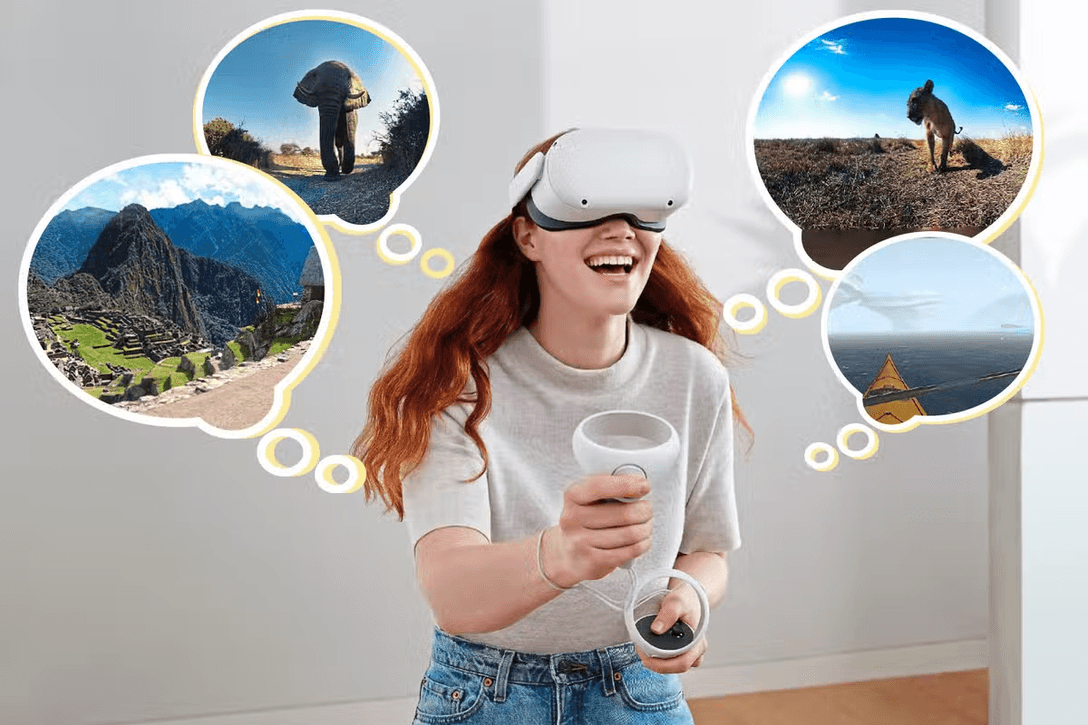

The ability of virtual travel firms to connect consumers to tours and travel experiences that would be once-in-a-lifetime in the physical world is a prominent feature. Travel agencies can arrange once-in-a-lifetime journeys in the metaverse for users who would not otherwise be able to afford them since there are no boundaries or prohibitive travel costs.
Inspiring real-world travel is another advantage of the virtual tourism sector, as viewing attractive sites increases people’s desire to visit them in person, enhancing passenger satisfaction.
There is also the possibility for enhanced booking experiences, in which prospective guests can tour hotels and preview destination attractions before their arrival. Altogether, the increased booking volume made possible by the metaverse enables a more holistic travel experience.
Accessibility and empowerment
The vast expansion and borderless nature of the metaverse have the potential to assist emerging and frontier economies. The internet has already facilitated the worldwide expansion of the labor force, enabling individuals from developing nations to work for western firms and improve their economic standing.
Now, the metaverse could make it possible for more workers to participate in jobs and educational possibilities that were previously inaccessible, improving the prospects for individuals who previously had limited options.
Additionally, the empowerment extends to other communities that require enhanced accessibility. One of the primary goals of the metaverse is to create immersive virtual worlds that simulate the experience of real-world connectedness. This can make the internet, and consequently the metaverse’s possibilities, more accessible to individuals who are disenfranchised due to neurodiversity, disability, or other limitations.
This creates a great opportunity for tech platforms and their partners to innovate and standardize more accessible user experience elements, enabling the broader market to shape a new digital connection and comprehension era.
This fundamental principle of universality translates immediately into new technologies and chances for businesses to be at the forefront of innovation. While the universality of producing accessible technology will increase access for those with disabilities or those from developing communities.
Implementing these concepts into the metaverse’s design will surely create a more engaging experience for all users.
Closing
Since Facebook rebranded to Meta, the interest in virtual real estate has spiked, reaching the peak of the hype cycle early this year. Launched as a traditional video game in 2012, The Sandbox has become one of the leaders in the web3 metaverse race. The community-driven approach allows artists, gamers, and creators to develop, exchange, and distribute digital assets and has become a standard for the industry.
Moreover, The Sandbox LANDs are not typical metaverse plots. Landowners can monetize their NFTs differently, making it one of the most enticing metaverse platforms available. In addition, many partnerships, including some of the biggest brands in the world, are just the latest reminder of The Sandbox’s high ceiling.
The latest proof to the ecosystem’s potential is The Alpha Season 3, a successful campaign that attracted over 220,000 unique visitors to the immersive experiences. Behind its leading gaming offering, and a complete crypto ecosystem,The Sandbox remains poised as one of the names to follow in the next years.
- SEO Powered Content & PR Distribution. Get Amplified Today.
- Platoblockchain. Web3 Metaverse Intelligence. Knowledge Amplified. Access Here.
- Source: https://dappradar.com/blog/the-sandbox-special-report-understanding-lands-potential
- 000
- 1
- 10
- 100
- 2012
- 2021
- 2022
- 3d
- 7
- 70
- 9
- 98
- a
- abilities
- ability
- Able
- About
- access
- accessibility
- accessible
- According
- across
- Action
- active
- activities
- addition
- Additionally
- Adidas
- administration
- Adoption
- advancements
- ADvantage
- advantages
- Advertise
- agencies
- agency
- Aid
- Alibaba
- All
- all-time highs
- allows
- Alpha
- already
- alternative
- American
- among
- Analysts
- and
- announced
- Another
- anyone
- Aoki
- APE
- Apparel
- appeal
- Application
- applications
- approach
- April
- Arab
- AREA
- areas
- around
- arrival
- Art
- Art Galleries
- artificial
- artificial intelligence
- Artists
- asian
- aspect
- aspects
- asset
- Assets
- assist
- Assistance
- atari
- attempting
- attendance
- attracted
- attractive
- Auction
- audience
- audiences
- AUGUST
- available
- avatar
- Avatars
- back
- Balenciaga
- BAND
- Bear
- Bear Market
- Bears
- because
- become
- becoming
- before
- Beginning
- behind
- Beijing
- believes
- benefit
- benefits
- BEST
- between
- bid
- Big
- Biggest
- Billion
- binance
- Bitcoin
- blockchain
- blockchain technology
- boost
- borderless
- Bored
- BORED APE
- Bored Ape Yacht Club
- boundaries
- brand
- branded
- branding
- brands
- Breaking
- bridged
- bridging
- broader
- brokers
- build
- Building
- Bundle
- business
- businesses
- Buying
- Campaign
- capabilities
- capital
- care
- carry
- case
- cases
- ceiling
- celebrities
- ceo
- certain
- challenges
- challenging
- chances
- characteristics
- charge
- China
- chinese
- Cities
- City
- claims
- classified
- closely
- closing
- club
- CoinMarketCap
- collection
- COM
- come
- Commerce
- commercial
- communicate
- Communities
- community
- Community Driven
- Companies
- company
- complete
- completely
- component
- concept
- concepts
- concert
- concerts
- conclusion
- conditions
- Connect
- connected
- connection
- Consequently
- consideration
- considered
- constitute
- constraints
- consumer
- Consumers
- content
- content creators
- continues
- continuing
- contracts
- contributed
- control
- convenience
- cooperation
- Costs
- could
- cover
- Crash
- create
- created
- creates
- creation
- creations
- creatives
- creator
- Creator Economy
- creators
- crucial
- crypto
- Crypto ecosystem
- Crypto Industry
- Crypto Winter
- cryptocurrency
- Cryptocurrency Wallet
- Cryptokitties
- Current
- Current state
- Curriculum
- customer
- Customers
- customize
- cyber
- data
- Date
- Days
- dead
- decade
- decentralized
- defining
- Demand
- Depending
- deployment
- Design
- designers
- Despite
- destination
- develop
- developed
- developers
- developing
- Development
- different
- different forms
- digital
- Digital Assets
- digital avatars
- Digital economy
- digital ownership
- digitalization
- direct
- disabilities
- discuss
- discussed
- distribute
- distributed
- distribution
- Dont
- down
- drive
- driven
- Dubai
- during
- e-commerce
- each
- Early
- earn
- Earning
- Economic
- economies
- economy
- ecosystem
- Education
- educational
- educators
- effectively
- elements
- ELEVATE
- emergence
- emerging
- Emirate
- emirates
- empowering
- empowerment
- enable
- enables
- enabling
- encompassing
- Endless
- engage
- engaging
- enhanced
- enhancing
- Entertainment
- entirely
- entry
- Environment
- Era
- ERC-721
- especially
- essential
- establish
- established
- establishing
- estate
- etc
- ethereum
- Even
- Event
- events
- example
- exchange
- Exclusive
- Expand
- expanding
- expansion
- expected
- expensive
- experience
- Experiences
- experts
- exploration
- exponential
- extension
- facilitate
- famous
- Feature
- featured
- Features
- fee
- feedback
- Fees
- Fields
- Figures
- financial
- Firm
- firms
- First
- first time
- Focus
- focuses
- focusing
- follow
- follows
- Forbes
- Force
- forefront
- form
- forms
- Forum
- Free
- from
- Frontier
- Frost
- full
- full-fledged
- function
- fundamental
- funding
- further
- Furthermore
- future
- Gain
- game
- Gamers
- Games
- gaming
- gap
- GAS
- Gemini
- General
- generate
- generated
- generation
- geographic
- get
- gig economy
- gigs
- Give
- giveaway
- giveaways
- given
- globe
- Goals
- goods
- governance
- Government
- Governments
- great
- Ground
- Group
- Growing
- Growth
- Gucci
- guests
- Hardware
- Hardware Wallets
- headsets
- healthy
- height
- here
- High
- higher
- Higher education
- Highs
- Hilton
- historical
- holder
- holders
- holds
- holistic
- host
- hosted
- hotels
- How
- However
- HTML
- HTTPS
- Humans
- Hundreds
- Hype
- ideal
- ideas
- identities
- immediately
- immersive
- impacted
- impactful
- important
- impose
- impossible
- improve
- improving
- in
- inaccessible
- Including
- Income
- Increase
- increased
- Increases
- increasing
- independent
- individuals
- industry
- influencers
- information
- Informational
- Infrastructure
- initial
- initiatives
- innovate
- Innovation
- innovations
- instance
- integrations
- Intelligence
- intends
- interact
- interactions
- interactive
- interest
- interested
- interesting
- Internet
- Interoperability
- interoperable
- Into the Metaverse
- introducing
- Invest
- investing
- investment
- involve
- IT
- items
- itself
- Jobs
- jobs in the metaverse
- join
- joining
- Journeys
- just one
- Keen
- Key
- korea
- labor
- Labs
- lagging
- Land
- landowners
- lands
- landscape
- language
- laptops
- large
- largest
- Last
- latest
- launch
- launched
- lead
- leader
- leaders
- leading
- learning
- Ledger
- Length
- Level
- levels
- likely
- limitations
- Limited
- limited-time
- Listed
- live
- local
- location
- longer
- looking
- Low
- Lyft
- made
- major
- Majority
- make
- make money
- maker
- Making
- many
- map
- Market
- market conditions
- market research
- Marketing
- marketplace
- McKinsey
- meaningful
- means
- Meanwhile
- Media
- medical
- medium
- merging
- Meta
- metal
- Metaverse
- Metaverse city
- Metaverse Communities
- metaverse platform
- metaverse platforms
- Metaverse-related
- Metrics
- might
- Milestones
- Military
- Military Applications
- million
- millions
- mint
- model
- models
- monetization
- monetize
- money
- months
- more
- Morning
- most
- Most Popular
- move
- multi-year
- multiple
- Multiverse
- municipal
- Music
- musical
- names
- Nations
- Nature
- Need
- New
- new products
- New technologies
- next
- NFT
- NFT industry
- NFT owners
- NFT trading
- NFT utility
- NFTs
- NIKE
- notable
- November
- number
- numbers
- numerous
- obstacles
- offer
- offering
- Offers
- official
- Official Website
- On-Chain
- on-chain data
- ONE
- ongoing
- online
- open
- Operations
- opportunities
- Opportunity
- Options
- organizations
- Organized
- Other
- Others
- Otherside
- otherwise
- overall
- own
- owned
- owner
- owners
- ownership
- p2p
- paid
- paris
- part
- participants
- participate
- participation
- particular
- particularly
- partnered
- partners
- partnerships
- passive
- passive income
- past
- paying
- Peak
- People
- people’s
- Perform
- performances
- period
- person
- personal
- perspective
- physical
- Physically
- piece
- Place
- Places
- plan
- planning
- plans
- platform
- Platforms
- plato
- Plato Data Intelligence
- PlatoData
- Play
- player
- players
- Polygon
- Popular
- popularity
- positive
- possibilities
- possibility
- possible
- Post
- potential
- power
- predict
- preferences
- premier
- Premium
- present
- presentation
- Preview
- previous
- previously
- price
- primary
- principle
- Prior
- Producers
- Product
- Products
- professionals
- Program
- Programs
- progression
- project
- projects
- prominent
- promoting
- proof
- properties
- prospects
- provide
- provided
- providing
- public
- published
- purchase
- purchasing
- put
- Q1
- Quarter
- Race
- random
- ranging
- rapid
- rarity
- reach
- reached
- real
- real estate
- real estate market
- real world
- Reality
- realm
- recent
- recognize
- recovery
- regarding
- region
- registered
- regular
- released
- relevant
- remain
- remaining
- remains
- Renowned
- Rent
- report
- representing
- represents
- Republic
- require
- rescue
- research
- Reserve
- restricted
- retail
- retail industry
- retailers
- revenue
- review
- Rewards
- Rise
- risks
- roadmap
- sale
- sales
- SAND
- sandbox
- satisfaction
- Scalability
- scenarios
- School
- Season
- Second
- secondary
- Secondary Market
- sector
- Sectors
- security
- Seeks
- segments
- Selling
- September
- Services
- set
- settings
- several
- shanghai
- Shape
- Share
- Shop
- Shopping
- should
- show
- showcasing
- significant
- significantly
- simultaneously
- since
- Sites
- situations
- sizable
- Size
- sizes
- small
- Snoop
- Snoop Dogg
- So
- Social
- social media
- social platforms
- Socios
- sold
- some
- Someone
- South
- South Korea
- Space
- spaces
- special
- stake
- Staking
- standard
- start
- started
- State
- Steve
- Steve Aoki
- stores
- straightforward
- Strategic
- strategic partners
- Strategy
- Strengthen
- Student
- Students
- studios
- Study
- success
- successful
- such
- Sullivan
- supply
- Supports
- surely
- Surface
- surge
- Surrounding
- sustainable
- Take
- Tap
- Task
- teachers
- tech
- technological
- Technologies
- Technology
- terms
- Testing
- The
- the creator economy
- the metaverse
- The Sandbox
- The Sandbox Game
- The Walking Dead
- the world
- their
- themselves
- therefore
- Third
- this year
- three
- thriving
- Through
- throughout
- ticket
- tiktok
- time
- to
- together
- token
- Tokens
- tool
- tools
- top
- Topics
- Total
- TOTALLY
- Tour
- Tourism
- tours
- toward
- trade
- Trading
- trading volume
- trading volumes
- traditional
- traffic
- transferred
- translate
- Translation
- travel
- Travis Scott
- Trend
- trials
- Trillion
- true
- TSB
- two-thirds
- typical
- UAE
- Uber
- Ubisoft
- Ultra
- understanding
- unique
- United
- United Arab Emirates
- Universe
- unstoppable.
- Update
- us
- Usage
- USD
- use
- User
- User Experience
- users
- utility
- utilize
- utilized
- vacation
- value
- variety
- various
- Vast
- Vault
- venture
- venture capital
- Venture Capital Funding
- Ventures
- via
- Video
- video game
- Virtual
- virtual concert
- virtual land
- virtual real estate
- Virtual reality
- virtual world
- virtual worlds
- virtually
- vision
- visited
- visitors
- volume
- volumes
- Voting
- Voxel
- vr
- VR headsets
- W3
- walking
- Wallet
- Wallets
- Warner
- warner music group
- ways
- Web2
- Web3
- web3 and metaverse
- web3 brands
- Web3 Metaverse
- webp
- Website
- websites
- WEF
- well-known
- Western
- What
- What is
- which
- while
- WHO
- will
- winning
- Winter
- within
- without
- Women
- Won
- Work
- worker
- workers
- working
- works
- world
- World Economic Forum
- world of women
- world’s
- worldwide
- worth
- would
- writing
- X
- Yacht
- Yacht Club
- year
- years
- Yield
- Yield Guild Games
- Yoga
- You
- Your
- yourself
- youtube
- Yuan
- Zara
- zephyrnet









